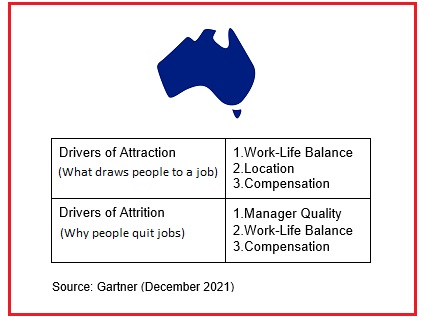The impact of extended COVID-19 lockdowns in major Australian cities took its toll on workers in Q3, 2-2021 as “discretionary effort levels” – or willingness to go above and beyond at work – fell to new lows.
Our Gartner survey conducted between July and September 2021 showed that the proportion of workers displaying high discretionary effort fell to 13.9%, down from 15.6% last quarter and 16.9% year-over-year.
Business confidence among employees in Australia also fell by 7.6% from 2Q21.
The proportion of employees actively seeking a new job rose slightly from 22.5% last quarter to 23.4% in 3Q21.
While 40.5% of Australian employees surveyed reported high intent to stay with their current employer, the Gartner survey found variability between job functions and industries.
For example, only 12% of Australian IT workers showed high intent to stay, pointing to a significant turnover problem.
The data paints a picture of a decline in Australian workforce health and confirms the heavy toll of more than 18 months living and working through a pandemic.
If there is any doubt that the ‘Great Resignation’ seen in the US is coming to Australia, this data dispels it.
It is likely there will be an increase in people leaving their jobs around March next year, once hiring picks up after the summer holidays and annual bonuses are paid.
While it’s too early to know what impact the new Omicron COVID variant will have on business confidence and job seeking behavior, the underlying data suggests employees are ready for change.
Act now to set expectations and retain staff
There is still an opportunity for organisations to get ahead of the problem, by providing clarity to employees before the end of the year on what to expect in 2022.

Work-life balance remains the top priority for Australians seeking a new job, and the number 2 reason for leaving, according to the Gartner survey.
We’re already seeing organisations pilot innovative solutions like 4-day work weeks, more flexible working arrangements and more comprehensive leave policies including paternal, miscarriage and menstrual leave.
Manager quality was the top reason employees reported for leaving their role, followed by work-life balance.
Even when an organisation’s policies allow flexibility, the implementation often still comes down to the employee’s direct manager.
Workers dissatisfied with their employer’s attitude and policies towards management and flexibility will likely use the holiday period to plan their next career move.
Compensation is now the number 3 reason why Australians would leave their current employer.
Two years ago, compensation did not appear in the top ten reasons for leaving.
To successfully retain staff, organisations must treat their employees as people, not workers, and invest heavily in re-designing work to be more human-centric.
Aaron McEwan is vice president, Gartner HR.
This content has been written by a topic area expert and is not a sponsored post or advertisement.









